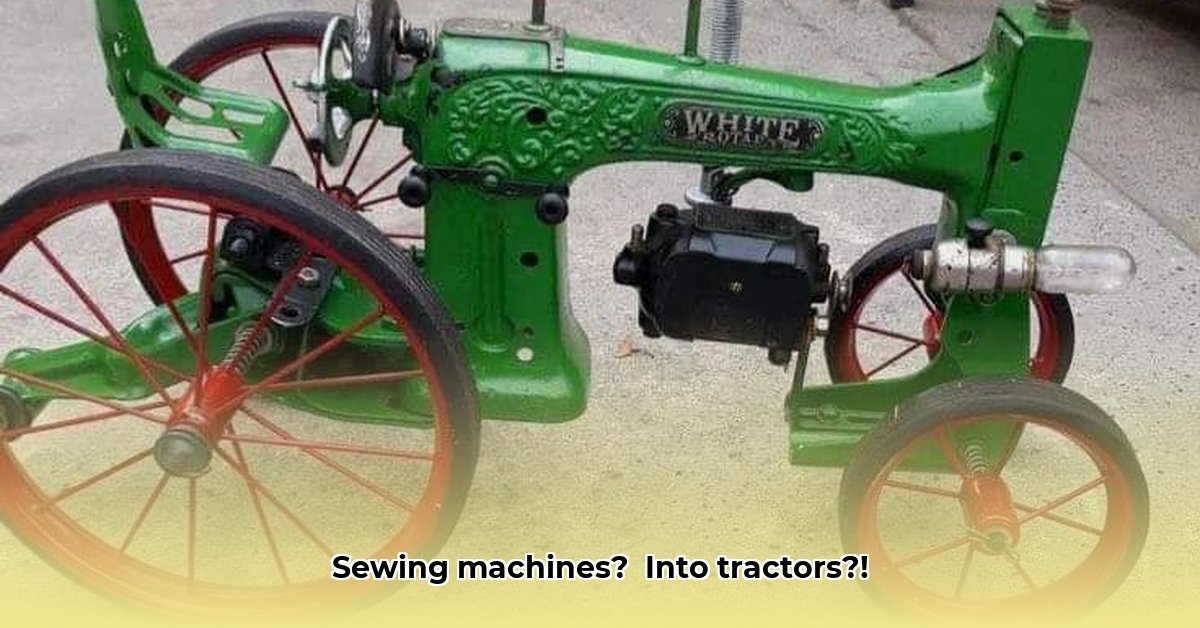
From Stitches to Steel: The Unexpected Life of a Sewing Machine
Imagine a miniature tractor, not mass-produced, but meticulously crafted from the remnants of a vintage Singer sewing machine. This captivating trend of upcycled Singer sewing machine tractors is gaining traction, showcasing human creativity and the transformative power of repurposing. Gene Blatchford, a prominent figure in this movement, reportedly crafted approximately 50 of these miniature marvels in just four years, highlighting the immense artistic potential hidden within discarded items. However, this transformation sparks a compelling debate: is repurposing a potentially functional machine into art a positive act, or a disrespectful alteration of its original purpose? This article explores both sides of this fascinating discussion, examining the artistry, market, and potential future of this unique craft. For more on vintage tractor restoration, check out this resource.
More Than Just a Bolt-On Project: The Art of Transformation
Converting a vintage Singer into a miniature tractor isn't a simple assembly; it's a labor of love, a delicate balance of engineering and artistry. Artisans meticulously disassemble the machines, separating usable components from scrap. The heavy cast iron base forms the sturdy chassis, while the iconic Singer wheels become the perfect miniature tractor tires. Sometimes, even the sewing machine's motor finds a new purpose, adding an industrial touch to the finished piece. This blend of nostalgia and modern creativity results in a breathtaking miniature work of art—a testament to the enduring appeal of both vintage machinery and the charm of rural themes. But how much time does it take? The process varies dramatically, depending on the detail.
A Niche Market for Miniature Masterpieces: Who's Buying These?
These unique creations aren't mass-produced; they're largely handmade, commanding prices around $80 each. This price reflects not only material costs but the extensive time and skill involved. They're primarily found on online marketplaces and at craft fairs, appealing to a specific audience. Buyers are often drawn to the nostalgic charm, the unusual blend of industrial history and artistic expression, and the inherent sustainability of upcycling. Collectors of vintage items, enthusiasts of farm heritage, and those drawn to the concept of repurposing find this craft uniquely appealing. The demand is niche, but the passion is undeniable. Is this a market poised for growth?
A Balancing Act: Saving History or Rewriting It?
The upcycling of Singer sewing machines naturally sparks debate. Some argue that converting functional machines into tractors is wasteful and disrespectful to history, preferring to see these vintage items preserved or restored for their original purpose. Others celebrate the creative reuse, highlighting the sustainable aspect and the unique beauty of breathing new life into old objects. This conflict highlights the inherent complexities of upcycling: the ethical implications vary depending on the object and its potential future use. There is no definitive right or wrong answer; it largely comes down to individual perspective and values. What are your thoughts?
The Future of the Trend: Uncertain, But Intriguing
The Singer sewing machine tractor trend is relatively new, making its future uncertain yet intriguing. The success of this niche craft hinges on several factors: continuous innovation in design, refinement of techniques, effective marketing, and securing a consistent supply of vintage Singer sewing machines. For collectors, this craft represents a unique blend of art, history, and sustainability. It also sparks ongoing conversations about the balance between preservation and creative reuse; these conversations will likely grow in intensity as this hobby gains momentum. Would you purchase one of these unique tractors?
Actionable Insights: Advice for Everyone Involved
Here's a breakdown of actionable insights for key stakeholders:
- Artisans: Focus on refining your processes, explore diverse online sales channels, and develop a unique brand identity—collaboration with other artists could also broaden your reach and visibility.
- Collectors/Buyers: Actively check online marketplaces and attend specialized fairs to discover unique pieces, and consider supporting artisans directly to foster growth within this community. Building a themed collection can also be very rewarding.
- Online Marketplaces: Create dedicated product categories to cater to this specific interest, highlight unique selling points for each tractor, and consider partnering with artisans for mutually beneficial promotional opportunities.
- Sustainability Advocates: Advocate for responsible sourcing of materials and support initiatives focused on repair and restoration, promoting the ethical side of upcycling.
The story of the Singer sewing machine tractor is a captivating narrative of repurposing, artistic innovation, and the enduring appeal of vintage items. Its enduring appeal lies in this fascinating blend of nostalgia and sustainability. Yet, much of its future remains to be seen.